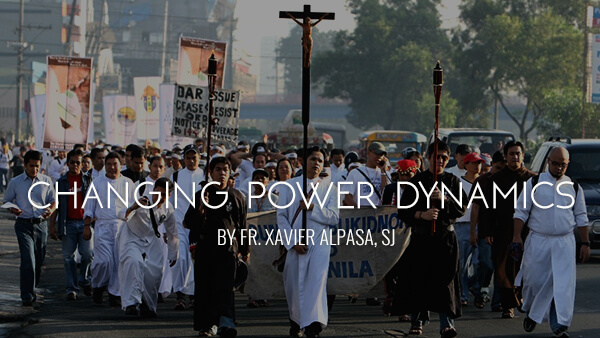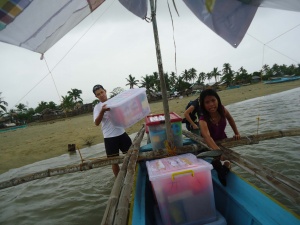


Fr. Xavier Alpasa, SJ
Executive Director, Simbahang Lingkod ng Bayan
February 25, 2016
Thirty years after the Filipinos toppled a dictator, we find ourselves with the late tyrant’s son in the Senate seeking the second highest post in the land.
So, you may ask Simbahang Lingkod ng Bayan, what has happened to People Power?
The response to this can be of exasperation, of giving up and just focusing on whatever works for oneself. The other track is to revise the whole history: to buy that image of a father who is now being presented as the most outstanding president in Philippine history and thus elect the son as vice president.
But we can instead choose to once again change the power dynamics and restore the balance back to where it was and how it should be: with the people.
Simbahang Lingkod ng Bayan (SLB) was born from the People Power of 1986 and 30 years after SLB keeps the spirit of this “revolution” alive. From serving as the Namfrel Marines (composed of hundreds of priests, nuns and seminarians literally embracing ballot boxes during the clearly rigged snap elections) that year to serving as secretariat and convenor of the country’s biggest electoral watchdog network Task Force Eleksyon this year, SLB perseveres in the mission of putting people at the center of politics.
Since its inception, SLB has actively served during elections by crafting an original and pioneering voters’ education program that has now evolved into this election season’s Kuwentuhang Bayan (KB), which now integrates a fuller module on political education. SLB has also become a Church organization of last resort for a number of national issues, including the historic case of the Sumilao farmers as well as the struggles of the Casiguran community now currently resisting development aggression as perpetrated by the Aurora Pacific Ecozone (APECO).
Aside from “political disasters,” SLB in its history has also been tapped for the biggest natural disasters: from 1991’s major Pinatubo eruption to 2013’s Super Typhoon Yolanda. And when the SLB Board challenged the team to soul-search over why we are into disasters, we discerned and realized that disaster response work is also a venue for a powerful exercise of good citizenship.
Indeed, the spirit of SLB is principally the spirit of People Power.
Almost all of SLB’s projects are community-oriented, from all the political programs to the disaster interventions. The evolved voters’ education program Kuwentuhang Bayan, for example, begins with a Socratic process of drawing out from people their experiences and distilling them into a National Situationer, before culminating in a Peoples’ Agenda that will be the springboard for upcoming national fora, including the March 14 Senatorial Forum and April 30 National Youth Agenda. Disaster rehabilitation programs including the pilot community-based disaster preparedness project, in partnership with DILG, begins and ends with the peoples’ organization Ugnayan ng mga Mamamayan ng Payatas (UMAKAP).
SLB believes the people still have the power.
We just need to remind ourselves that power does not simply reside with state authority, nor with those who can effect physical force, backed up by wealth. TED Speaker Eric Liu affirms these three sources of power but also cites three other possible sources – social norms, ideas and yes, numbers. I believe the last three manifested in full glory in the EDSA revolt.
These three sources also drive SLB to pursue programs in youth leadership formation such as BIDAhan, in partnership with the Catholic Educational Association of the Philippines (CEAP). The hope is that empowering and enabling thousands of youth leaders all over the country will encourage a norm of young people effecting change — of being “the change we want to see in the world,” as we take from Gandhi.
When SLB was confronted with the gravity of Yolanda’s damage, aggravated by the complex dynamics of indigenous communities who would not leave their ancestral lands that scientifically prove to be hazardous, the DRRM Team worked towards a Multi-Purpose Evacuation Hall (MPEH). The facility was designed with the Tagbanua communities of Culion, Palawan in partnership with the La Inmaculada Parish and expertly finalized by the OCB Architects who have produced some of Manila’s skyscrapers. While SLB is just a small NGO, we bank on breakthrough ideas that we hope can produce powerful norms translating to multiplying numbers.
Ultimately, SLB runs to prayer so we may be reminded of our mission for the people and the real Power.
The SLB maxim is Manalangin. Manindigan. Makialam. Monthly recollections, annual retreats and spiritual conversations ground us to our “Whys,” which allow us to survive any “Hows.” The Faith that does Justice mission can be very overwhelming if we forget what the word Faith actually means.
A true inspiration in this present moment is our Jesuit Pope who lives out the values we passionately believe in. His words resolutely affirm SLB’s foray into politics, which used to be regularly questioned by some sectors. In Evangelii Gaudium, he said,
“If indeed “the just ordering of society and of the state is a central responsibility of politics”, the Church “cannot and must not remain on the sidelines in the fight for justice.”

SLB continues to support the education, social welfare, and advocacy needs of Agta communities in Casiguran, Aurora.
Looking back, this was how the Church actually responded in the face of widespread public knowledge of tortures, disappearances, amassed wealth, cronyism, and a president who usurped all the powers of the sovereign people. Through Cardinal Sin who called people to EDSA, the Church broadcast on Radyo Veritas, nuns praying the rosaries while facing the nozzles of tanks, witnesses in soutanes witnessing to Divine Assurance — the People gathered and Power was manifested. This is the Church that is ecclesiologically defined as the People of God.
In the end, whatever happens with the May 2016 elections, SLB will continue to struggle with the people in its fight for a real Government of the People, by the People and for the People. Then and only then can Power fully and truly be called the People’s.
Simbahang Lingkod ng Bayan (SLB), then called the Namfrel Marines, began in 1986 during the EDSA Revolution as a network of religious, individuals, and organizations with the aim of safeguarding ballots as a way of promoting clean and credible elections. It grew as a non-profit organization with the mission of spreading social justice through its political education campaigns, socio-political advocacy, and most recently disaster response and rehabilitation. To know more and support the work of SLB, please visit their website here.